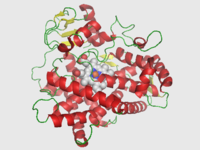
Photo from wikipedia
Abstract Objectives Clinical Pharmacogenetics Implementation Consortium (CPIC) is a platform that advances the pharmacogenomics (PGx) practice by developing evidence-based guidelines. The purpose of this study was to analyze the CPIC… Click to show full abstract
Abstract Objectives Clinical Pharmacogenetics Implementation Consortium (CPIC) is a platform that advances the pharmacogenomics (PGx) practice by developing evidence-based guidelines. The purpose of this study was to analyze the CPIC database for ADME related genes and their corresponding drugs, and evidence level for drug-gene pairs; and to determine the presence of these drug-gene pairs in the highest mortality diseases in the United States. Methods CPIC database was evaluated for drug-gene pairs related to absorption, distribution, metabolism, and excretion (ADME) properties. National Vital Statistics from Centers for Disease Control and Prevention was used to identify the diseases with the highest mortality. CPIC levels are assigned to different drug-gene pairs based on varying levels of evidence as either A, B, C, or D. All drug-gene pairs assigned with A/B, B/C, or C/D mixed levels were excluded from this study. A stepwise exclusion process was followed to determine the prevalence of various ADME drug-gene pairs among phase I/II enzymes or transporters and stratify the drug-gene pairs relevant to different disease conditions most commonly responsible for death in the United States. Results From a total of 442 drug-gene pairs in the CPIC database, after exclusion of 86 drug-gene pairs with levels A/B, B/C, or C/D, and 211 non-ADME related genes, 145 ADME related drug-gene pairs resulted. From the 145 ADME related drug-genes pairs, the following were the distribution of levels: Level A: 43 (30%), Level B: 22 (15%), Level C: 59 (41%), Level D: 21 (14%). The most prevalent ADME gene with CPIC level A classification was cytochrome P450 2C9 (CYP2C9) (26%) and overall, the most prevalent ADME gene in the CPIC database was CYP2D6 (30%). The most prevalent diseases related to the CPIC evidence related drugs were cancer and depression. Conclusions We found that there is an abundance of ADME related genes in the CPIC database, including in the high mortality disease states of cancer and depression. There is a differential level of pharmacogenomic evidence in drug-gene pairs enlisted in CPIC where levels A and D having the greatest number of drug-gene pairs. CYP2D6 was the most common ADME gene with CPIC evidence for drug-gene pairs. Pharmacogenomic applications of CPIC evidence can be leveraged to individualize patient therapy and lower adverse effect events.
Journal Title: Drug Metabolism and Personalized Therapy
Year Published: 2022
Link to full text (if available)
Share on Social Media: Sign Up to like & get
recommendations!